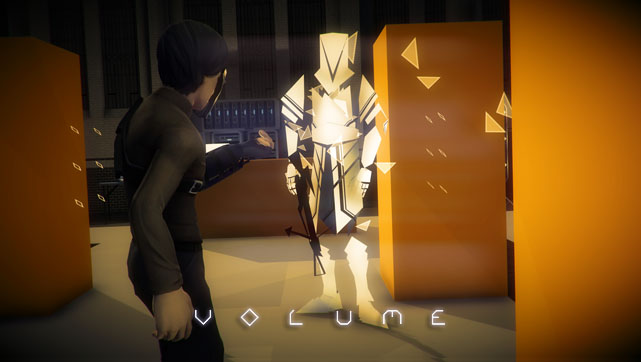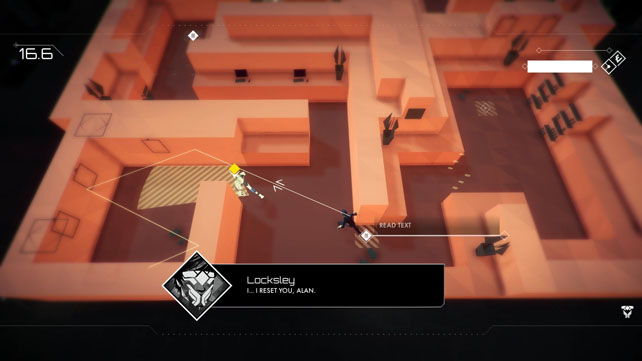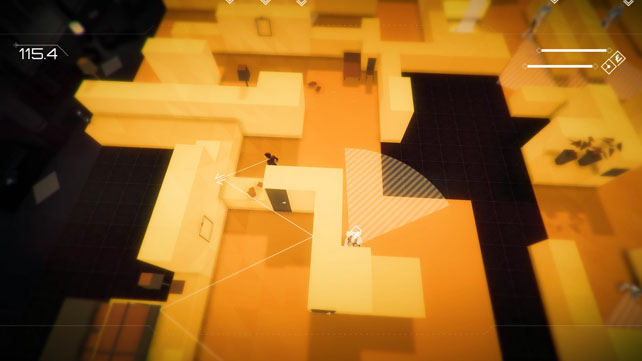Mike Bithell found huge success with his first game Thomas Was Alone – a simplistic puzzle platformer which focused heavily on narrative and the character developement of its titular star and his friends. Bithell’s return to the fray that is the modern indie scene comes in the form of Volume, a Robin Hood-esque 3D puzzler that focuses on stealth with a futuristic virtual reality like aesthetic. Should you turn it up to eleven or simply put it on mute?
The first, and easiest, criticism to lob at Volume would be that it bears a striking resemblance to Metal Gear Solid: VR Missions, and that is something of a contrivance. I will personally stand vehemently against such a criticism. While I will agree in design and even areas of the gameplay philosophy it does appear to be a hell of a lot like that particular game, to say that it apes it would be doing Volume a huge disservice. It would, in my mind, be a lot more accurate to say that this game is most assuredly inspired by MGS:VR, but elaborates on that to a point of becoming its own thing entirely. If you’re not familiar with the Hideo Kojima add-on, the purpose is to navigate VR constructed environments, mostly avoiding detection and playing with as many toys as you can. There lies the premise of Volume as well.
Narrative, the thing that people came to love about Thomas, is not as heavy a focus this time around, and that’s not to say there isn’t a story there at all. Players assume the role of Rob Locksley, a name that – for anyone familiar with the Nottingham based vigilante – is a clear Robin Hood reference. In a dystopian near-future England, the corporation known as Gisborne has used artificial intelligence to reshape the country in a way that will serve the rich while subjugating the poor. Rob, being a member of one of the more privileged families known as the The Protectors, discovers a way he can truly protect. With the use of a device known as a Volume, which can simulate real world environments, he goes about broadcasting his grand heists live to the proletariats of this new England.
Over the course of the game’s story, the character development for the artificial intelligence found in this particular Volume device, named Alan and played by Danny Wallace, is good; as is Wallace’s performance of this confused and conflicted AI. Sadly, the same can not be said about Charlie McDonnell who takes on the role of the game’s protagonist, Rob. As stakes rise and events grow more tense, the performance put forth remains rather flat and unaffected. Other notable cameos and voice performances come in the form of popular YouTube rapper Dan Bull, controversial critique/deity-like figure Jim “F***ing” Sterling, Son and last, but not least, Andy Serkis, who plays the face of the corporation, Gisborne.
It’s no small feat to make a game like this have the kind of feeling that makes you feel like you look good while doing it. Like God Of War or Spiderman 2 before it, every step you take in the right direction looks good and that way of thinking is enforced by the positive comments made by characters. Inversely, when you screw up, comments like “that must have been a glitch or something” further serve to make the player feel like doing so wasn’t really their fault, when it was… totally. It all works out as you reboot the instance and give it another go. Clinging to the wall at just the right moment, narrowly avoiding contact with the visually depicted enemies line of sight, tumble over the wall at the most precise moment and, with a well placed whistle, have them wandering off as you slink by, both care and home free.
If I were to criticize the game it would not so much be in regards to the variety or quality of the gadgets found within the game, but their frequency of use. From the bugle that allows you to direct sound to a particular around by bouncing it off walls and into other rooms, to the mimic that creates a clone of Rob that will cause guards to chase after it, they’re all a lot of fun to play with, and often you will find a favourite and then not see it in use for quite a while. Admittedly the ability to become invisible, make yourself appear as one of the guards themselves, or even the ability to sprint without triggering noise making pads on the floor may be overpowered. I feel the game could have been designed in such a way as to allow them to be more present over the games duration.
That said, the puzzles are good and varied. The difficulty in the first hour or so could do with a bit more of a curve, but there does come a time much sooner than the halfway point where the real challenge becomes apparent and gradually rises for the remainder of the game. Mike Bithell is a real talent of this current generation of indie developers. Thomas Was Alone was evidence that he knew how to make a great game using little more than shapes and story, and Volume is evidence that Thomas was not simply luck. This game retains the humour, the style and storytelling of his last efforts, whilst making the humour a little more insightful. The style has definitely matured and the storytelling is woven carefully into all that which surrounds it rather than taking centre stage. Not only this, but it brings more fun to the proceedings. As far as I’m concerned, it’s a great game.
A copy of Volume on Steam was provided by Mike Bithell’s PR team for this review, and the game is available now on PS4 and Xbox One as well as PC.
The Verdict
Latest posts by Cevyn (see all)
- Other Places – October 8, 2014
- Important Voices In Video Game Culture – October 2, 2014
- Hemorrhoids Of Shame – September 25, 2014







